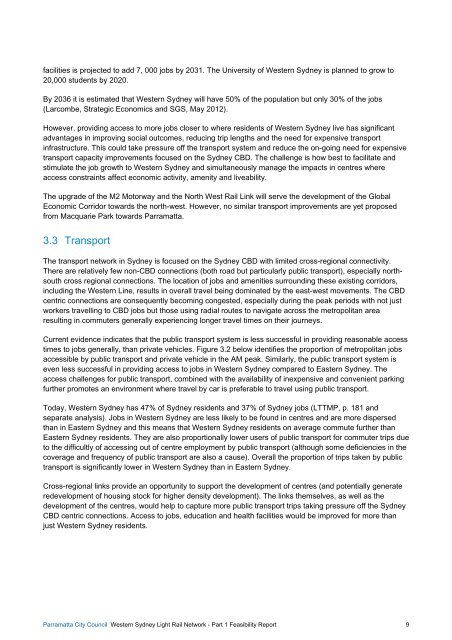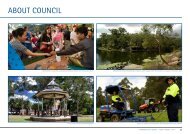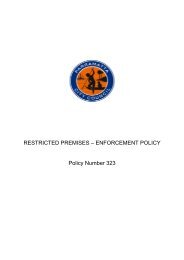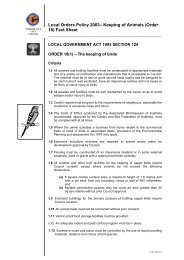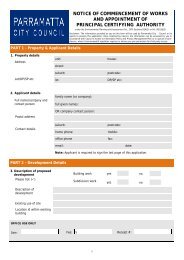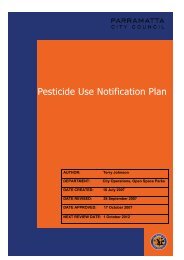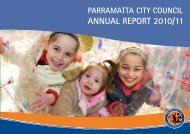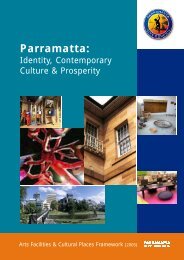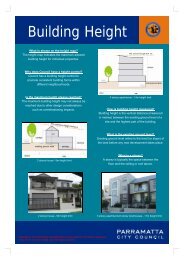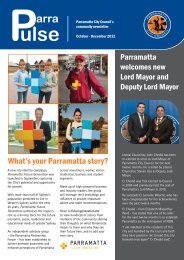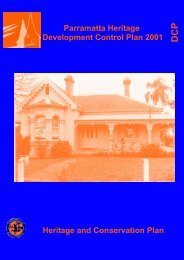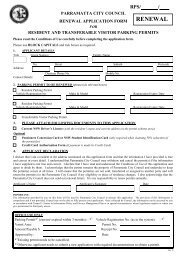Part 1 Western Sydney Light Rail Feasibility Report - Parramatta City ...
Part 1 Western Sydney Light Rail Feasibility Report - Parramatta City ...
Part 1 Western Sydney Light Rail Feasibility Report - Parramatta City ...
Create successful ePaper yourself
Turn your PDF publications into a flip-book with our unique Google optimized e-Paper software.
facilities is projected to add 7, 000 jobs by 2031. The University of <strong>Western</strong> <strong>Sydney</strong> is planned to grow to20,000 students by 2020.By 2036 it is estimated that <strong>Western</strong> <strong>Sydney</strong> will have 50% of the population but only 30% of the jobs(Larcombe, Strategic Economics and SGS, May 2012).However, providing access to more jobs closer to where residents of <strong>Western</strong> <strong>Sydney</strong> live has significantadvantages in improving social outcomes, reducing trip lengths and the need for expensive transportinfrastructure. This could take pressure off the transport system and reduce the on-going need for expensivetransport capacity improvements focused on the <strong>Sydney</strong> CBD. The challenge is how best to facilitate andstimulate the job growth to <strong>Western</strong> <strong>Sydney</strong> and simultaneously manage the impacts in centres whereaccess constraints affect economic activity, amenity and liveability.The upgrade of the M2 Motorway and the North West <strong>Rail</strong> Link will serve the development of the GlobalEconomic Corridor towards the north-west. However, no similar transport improvements are yet proposedfrom Macquarie Park towards <strong>Parramatta</strong>.3.3 TransportThe transport network in <strong>Sydney</strong> is focused on the <strong>Sydney</strong> CBD with limited cross-regional connectivity.There are relatively few non-CBD connections (both road but particularly public transport), especially northsouthcross regional connections. The location of jobs and amenities surrounding these existing corridors,including the <strong>Western</strong> Line, results in overall travel being dominated by the east-west movements. The CBDcentric connections are consequently becoming congested, especially during the peak periods with not justworkers travelling to CBD jobs but those using radial routes to navigate across the metropolitan arearesulting in commuters generally experiencing longer travel times on their journeys.Current evidence indicates that the public transport system is less successful in providing reasonable accesstimes to jobs generally, than private vehicles. Figure 3.2 below identifies the proportion of metropolitan jobsaccessible by public transport and private vehicle in the AM peak. Similarly, the public transport system iseven less successful in providing access to jobs in <strong>Western</strong> <strong>Sydney</strong> compared to Eastern <strong>Sydney</strong>. Theaccess challenges for public transport, combined with the availability of inexpensive and convenient parkingfurther promotes an environment where travel by car is preferable to travel using public transport.Today, <strong>Western</strong> <strong>Sydney</strong> has 47% of <strong>Sydney</strong> residents and 37% of <strong>Sydney</strong> jobs (LTTMP, p. 181 andseparate analysis). Jobs in <strong>Western</strong> <strong>Sydney</strong> are less likely to be found in centres and are more dispersedthan in Eastern <strong>Sydney</strong> and this means that <strong>Western</strong> <strong>Sydney</strong> residents on average commute further thanEastern <strong>Sydney</strong> residents. They are also proportionally lower users of public transport for commuter trips dueto the difficultly of accessing out of centre employment by public transport (although some deficiencies in thecoverage and frequency of public transport are also a cause). Overall the proportion of trips taken by publictransport is significantly lower in <strong>Western</strong> <strong>Sydney</strong> than in Eastern <strong>Sydney</strong>.Cross-regional links provide an opportunity to support the development of centres (and potentially generateredevelopment of housing stock for higher density development). The links themselves, as well as thedevelopment of the centres, would help to capture more public transport trips taking pressure off the <strong>Sydney</strong>CBD centric connections. Access to jobs, education and health facilities would be improved for more thanjust <strong>Western</strong> <strong>Sydney</strong> residents.<strong>Parramatta</strong> <strong>City</strong> Council <strong>Western</strong> <strong>Sydney</strong> <strong>Light</strong> <strong>Rail</strong> Network - <strong>Part</strong> 1 <strong>Feasibility</strong> <strong>Report</strong> 9


